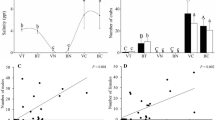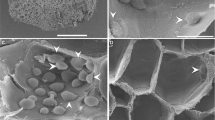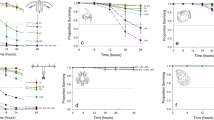Abstract
The presence in freshwater arthropods of organs capable of absorbing and reducing silver salts has long been recognized. Koch1,2 has brought forward evidence that these structures are probably sites of chloride absorption from the water. We have examined the silver-reducing properties of the gills of the two freshwater crabs, Potamon (Potamonautes) sidneyi Rathbun and P. (Potamonautes) depressus (Krauss). Each crab was washed in five changes of distilled water and then placed in a 0.05 per cent solution of silver nitrate for five minutes. The animal was then washed once again in distilled water and killed in 70 per cent alcohol. The branchiostegite was cut away and the gills exposed to sunlight for about fifteen minutes. The result obtained, which was similar in both species, is illustrated in the accompanying photograph. It will be seen that while the four anterior gills absorb and reduce the silver salt, no such effect is shown by the three posterior gills.
This is a preview of subscription content, access via your institution
Access options
Subscribe to this journal
Receive 51 print issues and online access
$199.00 per year
only $3.90 per issue
Buy this article
- Purchase on SpringerLink
- Instant access to full article PDF
Prices may be subject to local taxes which are calculated during checkout
Similar content being viewed by others
References
Koch, H., Ann. Soc. sci. Brux., 54, 346 (1934).
Koch, H., J. Exp. Biol., 15, 152 (1938).
Schlieper, C., and Herrmann, F., quoted in Krogh, A., “Osmotic Regulation in Aquatic Animals” (Camb. Univ. Press, 1939).
Dandy, J. W. T. (unpublished observations).
Maluf, N. S. R., J. Gen. Physiol., 24, 151 (1940).
Author information
Authors and Affiliations
Rights and permissions
About this article
Cite this article
EWER, D., HATTINGH, I. Absorption of Silver on the Gills of a Freshwater Crab. Nature 169, 460 (1952). https://doi.org/10.1038/169460a0
Issue Date:
DOI: https://doi.org/10.1038/169460a0



